Saltwater fish do not get more popular than the infamous blue tang. Gaining much of their notoriety from the Finding Nemo series, blue tangs, or "dories", much like the clownfish, have certainly become somewhat of a household name for saltwater hobbyists.
Something many people do not consider when it comes to this beautiful fish is their tank mates. We have curated a list of the best options to create a vibrant and harmonious underwater community.
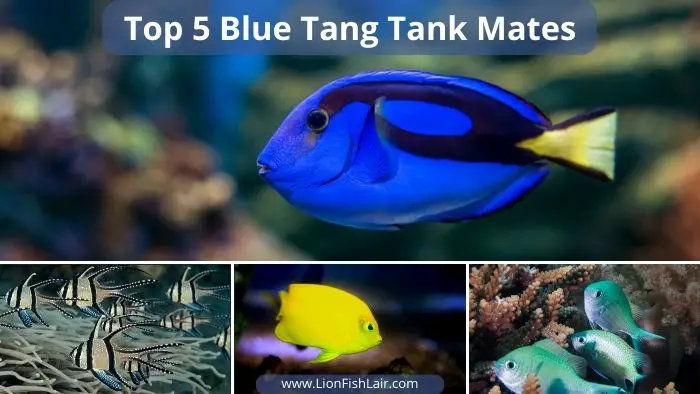
Finding a tank mate compatible with your fish is arguably the most important aspect of a tank setup, besides the obvious water quality requirements and temperature settings.
Let's take a look at some of our favorite blue tang tank mates. All of the fish that appear on our list share compatibility with blue tangs and also work well with them in an aquarium setting, complementing each other well.
5 Best Tank Mates for the Blue Tang
Here are five different fish species that are all compatible with blue tangs.
Something important to bear in mind though, is that some of the smaller subspecies on our list, such as the ocellaris clownfish subspecies are slightly less compatible due to size and risk of being bullied around, but they are still a safe bet!
You should pay a great deal of attention to the fact that blue tangs need a lot of space to live a healthy life. A popular tank size that many saltwater hobbyists opt for is 75 gallons (283.906 liters), however, despite being a reasonable size, this is still too small for the blue tang, who require plenty of space due to being such active swimmers.
In fact, they require a minimum tank size of 100 gallons (454 liters), but we'd recommend 125 gallons (473 liters) or more, especially when you factor in the additions of the fish below. Now, let's find out what fish can live with the blue tang!
1. Cardinalfish
The banggai and the pajama cardinalfish are the perfect two subspecies to reside with your blue tang. They both share very similar tank requirements to the blue tang, and are also tough enough to stand up for themselves, should things get a little heated.
Below is an image summarizing the tank requirements and additional information for the banggai cardinalfish and also the pajama cardinalfish:
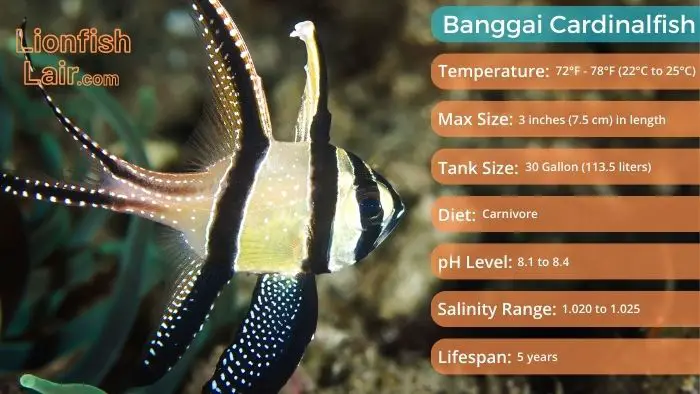
Tank requirements and additional information:
- Max size: 3.5 inches (8.89 cm) in length.
- Temperature range: 72 to 82°F (22.2 to 27.7°C).
- Minimum tank size: 30 gallons (136.3 liters).
- pH range: 8.1 to 8.4.
- Care level: Easy to care for.
- Temperament: Peaceful/semi-aggressive.
- Diet: Carnivore.
Banggai and pajama cardinals tend to enjoy living in groups of three or more, so, you must ensure that your aquarium has enough space to accommodate not only a group of cardinalfish but a big blue tang too.
2. Clownfish
It wouldn't be a list of blue tang tank mates without mentioning Dory's best friend, Nemo, right? Fortunately, this is not a fictional relationship, both clownfish and blue tangs can live together in harmony.
We would typically advise choosing a larger subspecies of clownfish, such as the maroon or tomato variants as they can handle themselves a bit better and are far less intimidated by the presence of larger fish.
The image below contains all of the key information regarding the beautiful and unique clownfish:
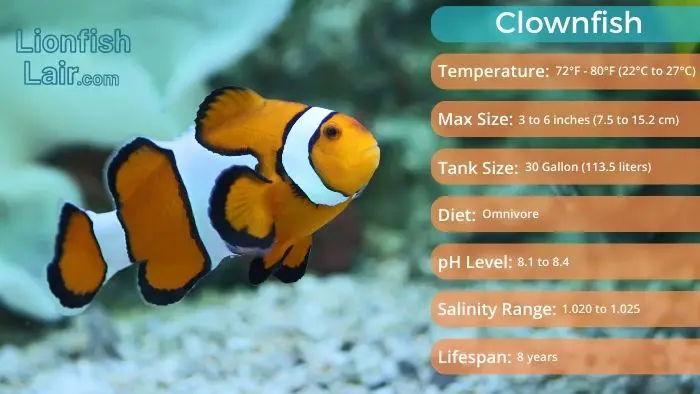
Tank requirements and additional information:
- Max size: Between 3 to 6 inches (7.62 to 15.24 cm) in length.
- Temperature range: 72 to 80°F (22.2 to 26.6°C).
- Minimum tank size: 20 to 30 gallons (90.9 to 136.3 liters).
- pH range: 8.1 to 8.4.
- Care level: Medium difficulty to care for.
- Temperament: Peaceful/semi-aggressive.
- Diet: Omnivore.
Typically, you will want to keep your clownfish on their own or in a pair, with a slightly added risk of them fighting, but this is usually an unlikely scenario.
Seeing both clownfish and blue tangs living together in your own aquarium is such a satisfying feeling, and you feel as though you have re-created the finding nemo world!
3. Chromisfish
Both the blue and green reef chromisfish are brilliant options to accompany your blue tang. They are beautiful fish that enjoy living in schools together, which is incredible to watch as their glistening chrome colors shimmer in the light as they majestically swim in a pattern together.
The graphic below summarizes the chromisfish's tank requirements as well as providing an overview of the fish:
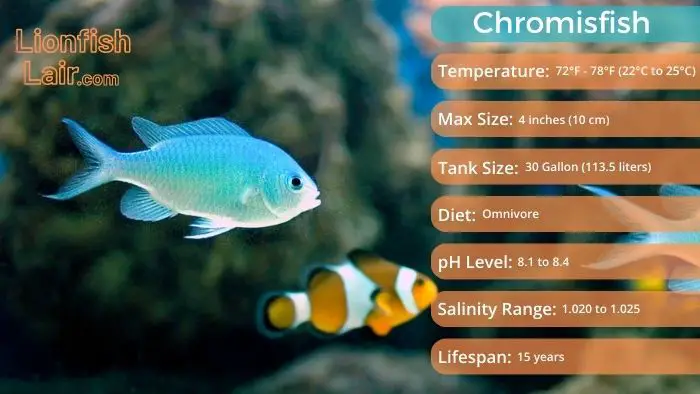
Tank requirements and additional information:
- Max size: 4 inches (10.16 cm) in length.
- Temperature range: 72 to 78°F (22.2 to 25.5°C).
- Minimum tank size: 30 gallons (136.3 liters).
- pH range: 8.1 to 8.4.
- Care level: Easy to care for.
- Temperament: Peaceful.
- Diet: Omnivore.
Chromisfish are not huge, but due to them needing to live in groups, you will need a pretty spacious aquarium to successfully and healthily accommodate both the blue tang and chromisfish.
4. Dwarf Angelfish
There are tons of amazing saltwater dwarf angelfish out there, with some personal favorites being bi-color, flame, and yellow angelfish.
Due to their tank requirements being almost identical, and their behavior being very similar too, you can house dwarf angelfish with blue tangs without any worries.
The graphic below showcases the pygmy angelfish subspecies and more specifically their requirements and general information:
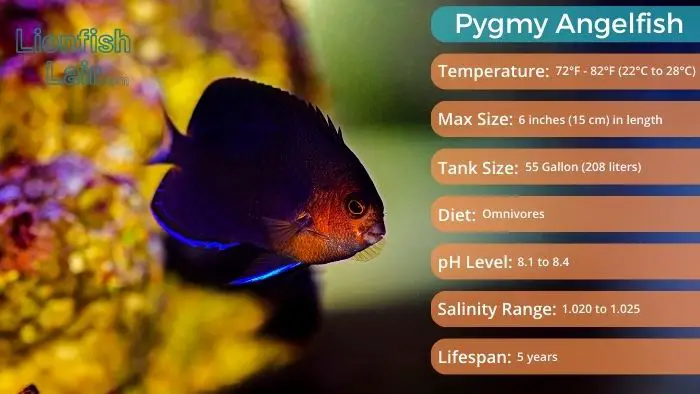
Tank requirements and additional information:
- Max size: Between 4.5 and 6 inches (11.43 cm - 15.24 cm) in length.
- Temperature range: 72 to 78°F (22.2 to 25.5°C).
- Minimum tank size: 50 to 70 gallons (227.304 to 318.226 liters).
- pH range: 8.1 to 8.4.
- Care level: Medium difficulty to care for.
- Temperament: Semi-aggressive.
- Diet: Omnivore.
These angelfish are semi-aggressive, which helps when it comes to holding their own with larger fish species. A timid and small fish will become stressed out if they are on the receiving end of bullying, and stress is never good for fish! Fortunately, these dwarf angelfish are big enough and confident enough to hold their own.
5. Gobies
Gobies are a fun, interesting, and insanely popular saltwater fish that have become somewhat of a household name amongst saltwater hobbyists.
They are perfect for reef tank setups, typically spending most of their days hiding in sand or substrate, where they usually stay very still, observing their surroundings. We have a graphical summary of the diamond watchman goby subspecies below:
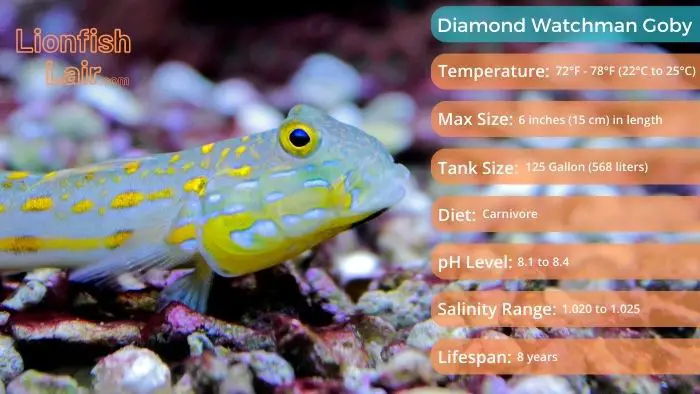
Tank requirements and additional information:
- Max size: 5 inches (12.7 cm) in length.
- Temperature range: 72 to 78°F (22.2 to 25.5°C).
- Minimum tank size: 30 gallons (136.3 liters).
- pH range: 8.1 to 8.4.
- Care level: Medium difficulty to care for.
- Temperament: Peaceful.
- Diet: Carnivore.
Despite being pretty bad swimmers, they are astonishingly fast - all you need to do is blink and your goby will have disappeared into their safe hole in the ground!
They do well in groups or on their own and have developed some very unique and symbolic relationships with other marine life over recent years. Some advice if you get a goby for your blue tang aquarium - add a few pistol shrimps and see what happens.
To conclude, blue tangs are beautiful and fascinating fish, that are super active requiring a lot of space. Something many people do not mention is the fact that they are not particularly beginner-friendly as they grow rather big, requiring a large tank and can be prone to diseases such as saltwater ich.
That being said, they are an incredibly rewarding fish to keep, and are also super friendly with most other fish, which is why they are compatible with a plethora of brilliant tank mates. With the right mix of compatible fish, you can create a thriving environment for your blue tang
So, choose wisely and enjoy the process!
